
|   |

|   |
World Dance Day celebrations at Bangalore - Sudha Sridhar e-mail: sudhasridhar@hotmail.com May 16, 2012 World Dance Day is celebrated on 29th April every year from 1982 as declared by Dance Council, UNESCO. The main objective of celebrating Dance Day is to attract the attention of the wider public to dance, with particular emphasis on reaching out to the ‘new’ public, people who generally do not follow dance events during the course of the year. In Bangalore, Shristi Centre of Performing Arts and Institute of Dance Therapy presented a rather elaborate celebration on account of World Dance Day 2012. The celebrations stretched across five days starting from April 29 to May 3, 2012. Around 50 performances were slated and the number of artistes easily exceeded 100 with the performances held at four different venues in Bangalore. This is a brief report covering a few performances that the institute had planned meticulously to include artistes from all over the country with an interesting spread of amateurs to professionals. The celebrations were preceded by Kanakasabha Nataraja Yagna performed at Ravindra Kalakshetra followed by invocation. Performances started with Pushpanjali, Bharatanjali, Devaranama by Shweta Lakshman, Prasanna Kumar and Vishaka Chandrasekar, disciples of Bharatanatyam guru Padmini Rao. There was a lec-dem by Odissi dancer Ashwini Raghupathy on relevance of Odissi dance to modern contemporary dance. She explained about the need to do certain exercises and the techniques to get the required rhythmic dance movements unique for an Odissi dancer. The demo was followed by an Odissi performance by Debasish Das from Bhubaneswar. He performed an item on Durga stuthi. The performance and choreography was of good standard as expected since he is a student of Guru Ratikant Mohapatra. 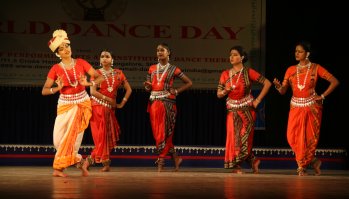 Madhulita Mahapatra and troupe (Odissi) 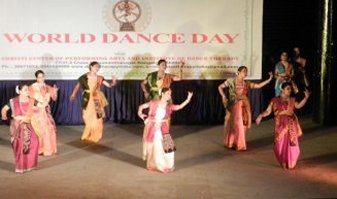 Sanchita Lahoti and troupe (Rabindra Nrithya) Kuchipudi Guru Rajani Malladi’s students from Hyderabad performed swarajathi in Bilahari ragam and Sri Ganapathim, Thyagaraya krithi. Her own composition Telugu Vaibhavam was rich in content and aimed at bringing out the greatness of Telugu. Sanchita Lahoti and her team performed Rituranga depicting six seasons in Rabindra Nritya, giving a rare opportunity for viewers of this part of the country to see the much acclaimed poetry of Rabindranath Tagore composed in fluid dance movements. It was well received. The event also showcased colorful Bommalattam (Doll dance) by KP Satish and group. In one of the sequences, the much popular Ramdas Keerthana ‘Paluke Bhangarama’ was intriguingly featured for a happy occasion (home coming of a couple after marriage) as against the original bhava of the song wherein Ramdas is gently chiding Lord Rama for not speaking to him when he is actually languishing for his grace. Due diligence needs to be used before selecting very popular keerthanas as background score either as a song or an instrumental rendition. Rain which rightfully followed the performance of Rituranga based on Tagore’s song turned out to be a soul stirring moment, since the song depicted the thirst of the earth being quenched by Lord Indra through rain and one could say the event was literally blessed. The audience braved the rain in the open air auditorium in the evening and their patience was well rewarded with a good performance of Kuchipudi by Preethi Tatambhotla from Hyderabad (a student of Shobha Naidu), Manipuri by Deepanjali Biswas and Bharatanatyam by students of Padmini Ramachandran. Shalini and Malini, daughters/disciples of Bharatanatyam Guru Manjula Paramesh, were seen dancing their best for Bhakta Markandeya’s story and thillana in Hindolam raga.  Anupama Bhushan (Kuchipudi) 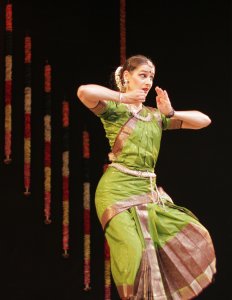 Maja Drobac (Bharatanatyam) 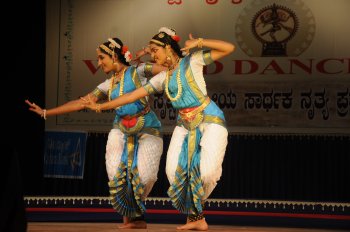 Swati and Priyanka (Bharatanatyam) 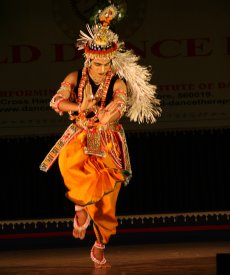 Sudip Ghosh (Manipuri) In the Kathak recital, Bharathi Vittal and Chitra Arvind chose to perform Dasavatara from Saint Purandaradasa’s keerthana. It was a refreshing approach by the duo, who had meticulously selected a south Indian keerthana and choreographed it in a north Indian style of dance which was captivating and brilliantly performed. It took the breath away and the audience was seen appreciating whole heartedly. Anupama Bhushan, an upcoming artist in the Kuchipudi style performed Mahishasuramardini and Marakatamani Tarangam, a Vempati Chinna Satyam composition. After a series of Bharatanatyam performances, it was refreshing to see Kathak, Odissi and Kuchipudi. Maja Drobac, a Bharatanatyam exponent from Europe performed a javali “ela radayena bhamini” with expressions which were near perfect like that of a classical dancer from this part of the world. Hats off to her guru Lalitha Srinivasan and the disciple whose dedication and hard work was evident from the excellent performance. The dance drama ‘Buddha’ by Satyanarayana turned out to be a colorful presentation. Emphasis was on natural free style dance motions and the topic depicted was apt with relevance to the predominant turmoil situation currently witnessed all over the globe. The message of inner peace propagated by Buddha through his life story was brought out lucidly without the general boundaries of a classical dance form. 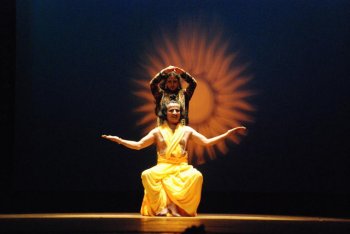 Buddha dance drama 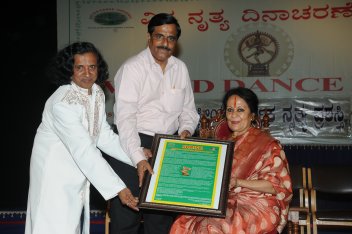 Dr. Sonal Mansingh receives award The event saw the presentation of Shristi National Achievement Award for Dance to Dr. Sonal Mansingh. In her address, the distinguished dancer, guru, choreographer and untiring ambassador of Indian dance, extolled upon the greatness of Indian classical dance forms in general and lamented that the same is not adequately showcased in the present day to so called modernized / westernized youth of the nation. Sonal Mansingh gave a clear message to the dance fraternity, media and cultural organizations to come together to propagate art and facilitate the youth to savor the richness of Indian classical dance forms. The major responsibility is with us, she added, and it is meaningless to comment upon the influence of other avenues that is luring away the energy and attention of the youth and unwittingly depriving themselves of the richness of our culture. Various forms of attention capturing steps to be initiated to reach out to the public and involve them in carrying on the rich traditions and meaningful existence that our culture offers to the world at large was emphasized by her. This event organized with a view to enable the larger audience of Bangalore to get a glimpse of all the dance forms in a capsule of five days did achieve the objective largely thanks to the efforts of Satyanarayana and the various thoughtful sponsors, and of course the artistes without whom there is no art to showcase and the discerning art lovers who thronged the venues. The need for cultural exchange even among the dance fraternity of the country and the urge to view, understand, learn from and appreciate other artistes is the need of the hour. It was seen during the event that the artistes per se in general walked out of the auditorium almost immediately after their performance, thereby missing an opportunity to appreciate other performing artistes and expand their horizon by opening up their hearts to all forms of dance. Credit has to be given to the organizers who religiously stuck to the time schedule and at least that should have encouraged the artistes and their entourages to hang around the venue till the end of each session. |